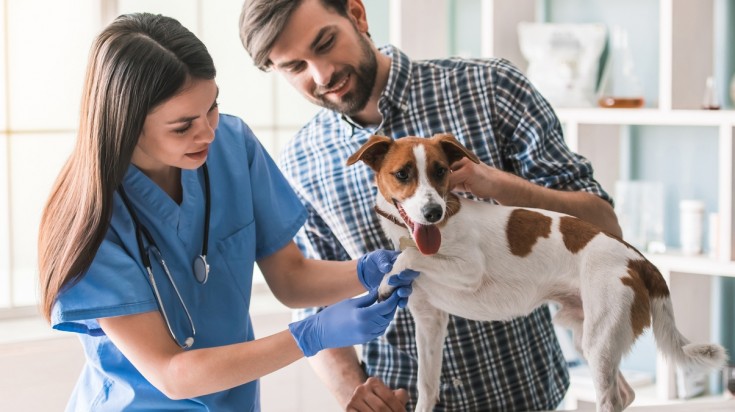Tips for Traveling with Pets

Preparing for the trip

For a first-timer, traveling with a pet can seem a bit of a minefield, but it doesn’t have to be, with some careful pre-trip preparation making the actual day a whole lot easier for everyone involved. Here’s what you should consider when preparing for the trip:
- First off, consider what’s best for your pet. If you won’t be able to spend much time with them while you’re away, they will probably be happier and healthier at home with a sitter or in a holiday kennel than in an unknown and unfamiliar environment. And while dogs enjoy investigating new places, cats are almost always more comfortable staying in their home environment.
- If your pet isn’t used to longer journeys and you’re traveling by road consider taking a shorter trial trip to gauge how they might respond. It’s a great way of showing them there’s nothing to be anxious about, and the perfect time to also gauge whether they may get travel sick or not. Whether your journey is by road or by air, it’s definitely worth getting your pet used to sitting in a travel crate if that’s what you’re going to do on the big day. Experts generally recommend a month of familiarity to limit the stress your pets might feel.

- Talk to your local vet to ensure they are happy with the planned trip and to get any vaccinations that may be required. If your pet takes long-term medicine, ensure you have enough to last until your return. You’ll also want to check the legality of any pet medicines you’ll need in other states and jurisdictions. Sedating your pet is now not generally recommended as it can interfere with breathing.
- Pick a hotel or guest house that openly welcomes pets like yours. Also check your chosen holiday destination for adverse weather conditions, endemic diseases or disease outbreaks that may affect your pet, and to ensure that destination permits entry to pets. Some countries have very strict entry and quarantine requirements.
- A Pet Alert Emergency Information Kit can be handy while traveling with pets. Such pet rescue kits alert emergency personnel about your pet and give proper information quickly in case the pet parents are involved in accidents or natural disasters. Keep a kit inside the car or hotel room while traveling. This will help save the lives of pets that could otherwise go undetected in case of emergencies.
5 Tips for traveling with pets by road

Traveling with pets by road is certainly an easier option than traveling with animals by air. However, there are still a few tips that you should keep in mind:
- Always make sure pets are restrained inside a travel crate, behind a pet barrier, or with a pet seatbelt when driving. Thousands of accidents each year are caused by free-moving animals distracting drivers. Securing a pet also reduces the chances of them becoming injured should an accident occur. For the same reason, keep pets in the back or on the rear seats of the vehicle, and not in the front seats where air bags may deploy and injure them.
- Ensure you have a ready supply of cool water to hand for the journey, to ensure your pet remains hydrated throughout the journey. Also have some food to hand in case of unexpected delays.
- Keeping a pet hydrated inevitably means planning plenty of rest stops where pets can use the bathroom and get some exercise. The experts recommend a stop every two to three hours, but keep them on a leash or lead in unfamiliar environments in case they panic and run off.
- Pets should always travel wholly inside of a vehicle — however much they may enjoy having their heads stuck out of the window in the rush of oncoming air. Even driving at city speeds of 30-40 km/h can result in serious injury from flying debris, while cold air can also cause colds and other illnesses.
- Travelling as a (human) pair makes keeping an eye on a pet during a journey much easier. It also means you can take turns looking after the animal when nature calls for you too. Either way, a pet should never be left alone in a vehicle. Heat can increase very rapidly in a sealed vehicle and can have fatal consequences, while thieves also target unattended pets.
9 Tips for traveling with pets by air

The decision to fly with a pet shouldn’t be taken lightly. Animals respond better to travelling by road where they remain close to familiar faces, and traveling by air is not without risk (for anyone), but should you need to take them by air, consider our tips below:
- You can never have too many labels — double up on the labels on the outside of the travel crate if you’re using one, and consider adding an additional tag to any collar too. The information you need to include is your full name, home address, telephone number and information for contacting you while on holiday as well should this be different. Some vets also recommend you give your pet a means of permanent identification by way of a microchip that sits beneath the skin and can be scanned to provide officials with the relevant information — so long as it’s kept up to date.
- Check out how your pet can travel, and that you’re happy with this. Some airlines allow pets inside the cabin, while others require them to travel as ‘cargo’ in the hold — generally cats and smaller breeds of dog are permitted in the cabin. It’s also worth noting that animals with shortened faces, such as pugs and Persian cats, particularly struggle with the reduced oxygen levels and temperature changes that come with hold travel. The age of the animal (if very young or very old) and overall health should also play a part in your final decision.

- Ensure you have all your pet’s papers in order and up to date, and take them with you if traveling across state lines or outside of your home country. You’ll need these documents to prove your pet has had any necessary vaccinations.
- Make sure the travel crate you’ve purchased is large enough. There should be enough room inside for the animal to sit, lie down, stand up, and turn around in without striking its head. You should include bedding (shredded newspaper will do) to make them more comfortable; a familiar blanket or toy is a big help in making them less anxious. Most animal organizations also recommend including food and water bowls, though you should avoid feeding pets for between six and eight hours before traveling. Crates should be securely closed, but not locked shut, so animals can be retrieved in case of an emergency.
- Tiring your pet out as much as possible with some exercise before the flight makes its more likely the animal will relax and sleep during the flight, further reducing tension.
- Using direct flights minimizes the amount of time your pet will be inside a carry crate and away from you in an unfamiliar and potentially noisy environment. It also removes the risk of long periods sitting unprotected on the tarmac at connecting airports, and mistakes in transferring pets traveling as cargo between aircraft holds.
- Travel on the same flight as your pet and ask if it’s possible to watch your animal being loaded if its traveling in the hold. Also, ask a flight attendant to inform the captain of their live cargo as a further safety measure.
- Carry a recent photograph. Should the worst happen and your animal gets lost, this will make it much easier for staff who may not know dog or cat breeds to identify your pet and get them back to you as quickly as possible.
- Check your pet for injuries as soon as you can after your flight arrives, and seek the advice of a local vet immediately should you find anything that worries you. Having the details of a couple of recommended local vets to hand will make this all the easier.
Planning is key when opting to travel with a pet either on a journey by road or by air. These tips for traveling with pets help streamline the process whether you’re a first or long-time traveler with pets.

